Burke-Khang Final Summit Push
Gokyo to Base Camp
We moved up from the village of Gokyo to Base Camp on October 30. Fourteen yaks and a large group of porters carried our gear to Base Camp. Base Camp was the start of our self-sufficiency on the mountain as we slept in tents and cooked our own food. Our Base Camp was established at an altitude of 16,404 feet and was situated on a large, flat plateau near Gokyo Lake # 5. The location was perfect as we were surrounded by towering, picturesque Himalaya peaks, and the shimmering lake provided us with easy access to pure alpine water for drinking and cooking. From Base Camp, and for the rest of the climb, we had spectacular views of Mt. Everest.

Burke-Khang Base Camp

Burke-Khang Base Camp
Each person had their own sleeping tent at Base Camp. We also had a cook tent, dining tent, shower tent and toilet tent. A gas powered generator provided heat and light at night for the dining tent. The meals prepared by our wonderful cooks were outstanding. One night, the cooks brought us fresh, homemade tomato soup, followed by a main course consisting of sizzling platters of pasta, chicken and vegetables. Delicious birthday cakes were baked for our birthday boys and girls. We even enjoyed an early Nepalese Halloween at Base Camp in which team members donned lavish Halloween costumes. In sum, we enjoyed all the comforts of home.

Halloween at Base Camp
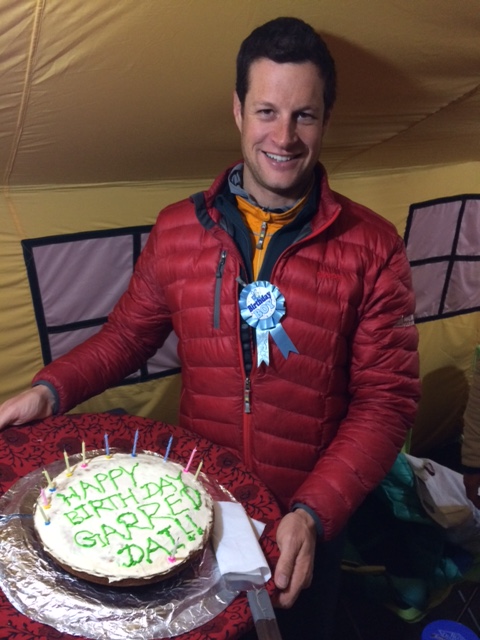
Garrett Madison turns 37 at Base Camp
From the edge of our Base Camp plateau, we had a spectacular view of the intersection of the Ngozumba Glacier and the Guanara Glacier. Looking down at these glaciers from our perch on the high plateau was like looking down the Grand Canyon. The glaciers were enormous in depth and size. The view of these massive glaciers was awe-inspiring and made me ponder the enormous task ahead, as our mountain was miles away and nowhere in sight.
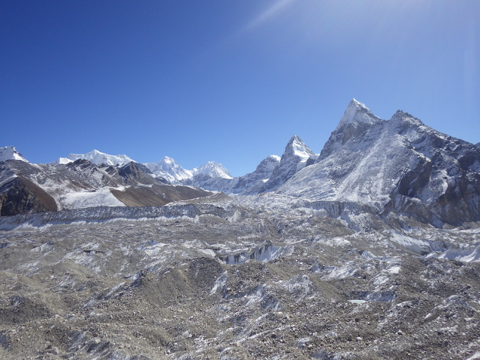
Looking across the Ngozumba Glacier up the Guanara Glacier with Mt. Everest looming in the background
Our trekking team spent 1 day at Base Camp and, on October 31, headed down the Gokyo Valley for the return trip to Lukla. We said our farewells and bid them safe travels. They enjoyed a special treat on their return trip since they crossed over the Cho La Pass and picked up the Everest Trekking Trail. This allowed them to visit Everest Base Camp and return to the village of Gorak Shep where they climbed Kala Patar. From the summit of Kala Patar, they enjoyed spectacular views of Mt. Everest. They then spent 8 days trekking down the Everest Trekking Trail to Lukla. This intrepid group of travelers thus had the unique opportunity to trek up the Gokyo Valley to Base Camp and down the Khumbu Valley to Lukla.

Bidding farewell to our trekkers-Rebecca, Martha & Daniel
The climbing team spent 5 days at Base Camp. Each day, we completed acclimatization hikes up the surrounding mountains to help our bodies adjust to the thin air and be prepared for the move to higher altitudes. The highlight of these acclimatization hikes was our hike to Cho-Oyu Base Camp. Cho-Oyu is the 6th highest mountain in the world and, like Mt. Everest and Burke-Khang, is a border peak, since it straddles the countries of Nepal and Tibet. Our hike to Cho-Oyu Base Camp was a special treat since Cho-Oyu is rarely climbed from the South (Nepal) side of the mountain. Our view of the South Face of Cho-Oyu was absolutely breathtaking. During our stay at Burke-Khang Base Camp, we also practiced our climbing skills, including ascending with our jumars and descending with our figure 8 rappelling devices.
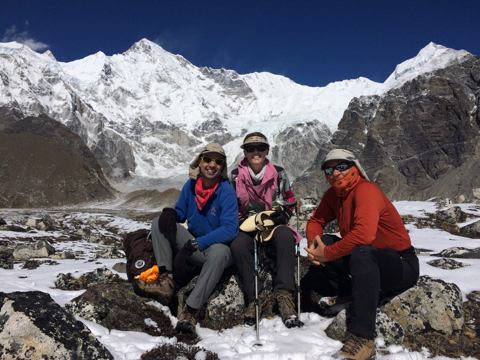
Paul, Denise & Nick with the South Face of Cho-Oyu in the background
Unfortunately, our climbing team suffered attrition at Base Camp. On the morning of November 1, John (“Coach”) Dahlem informed me that he had suffered a severe “blow out” of his back. A disc had become inflamed during the night, and he was in severe pain. This was a recurrence of his back problem that occurred in the most unfortunate of circumstances. Coach was severely distraught at this development, as was the entire team. Coach is a close friend, one year younger than me, and he is a super strong and highly motivated climber. We had no choice but to summon a helicopter to fly him back to Lukla.

Coach on his way home
So, now our climbing team was reduced from 7 to 5 as Bud Allen had left the team at Gokyo because of a stubborn virus. We were keeping the choppers busy.
Sid spent 1 night at Base Camp and then moved up with the Sherpa team to establish Advanced Base Camp and begin fixing lines and establishing Camp 1 on Burke-Khang.
Base Camp to Advance Base Camp
On November 5, we received word that the line fixing team had made good progress fixing lines on Burke-Khang, so we began our move up to Advance Base Camp. This move up began with a major move down. We rappelled down from the plateau where our Base Camp was established to the base of the Ngozumba Glacier. This was like rappelling down a 15-story office building. Once we reached the bottom of the Glacier, we had to travel over 1-mile across the Glacier to where it intersected with the Guanara Glacier. There was no trail to follow, as this was virgin terrain, and the glacial moraine presented major obstacles of all sizes and shapes. Many of the boulders were the size of houses, and we had to scramble up, over and around these boulders. Once we crossed the Ngozumba Glacier, we arrived at the Guanara Glacier, which led up the Gokyo valley to Burke-Khang. Rather than move up the middle of the Guanara Glacier, we climbed back up the glacial wall until we reached a plateau that tracked the path of the Glacier up the valley.

The climbing team marveling at the Grand Canyon of Glaciers
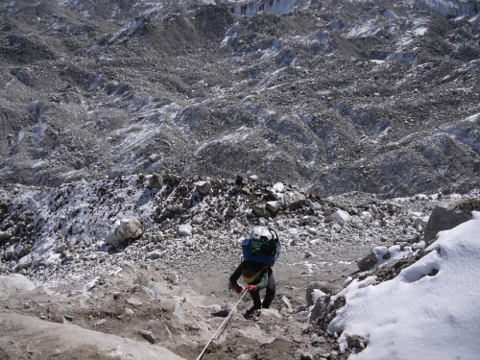
Rappelling down to the Ngozumba Glacier

Crossing the Ngozumba Glacier
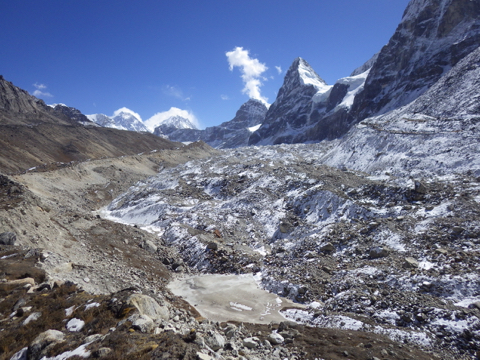
Moving up the Guanara Glacier
The 9-mile move to Advance Base Camp was horrendously difficult and drained all of us of every ounce of energy. After more than 9 hours of torture, we finally reached Advance Base Camp where we collapsed in our tents. Yet, even with all that time, distance and effort behind us, we were still 5 hours away from Burke-Khang, where the real climbing was scheduled to begin. Kathy Myers had an especially difficult time making it to Advance Base Camp as she had been battling a respiratory infection for several days.
Advance Base Camp was situated at 17,864 feet on another high plateau far above the Guanara Glacier. This camp was definitely more primitive than our first camp. There was no dining tent, shower tent or generator for heat and light. Our food was more basic and less tasty and nutritious. Most of us shared a tent with a climbing partner. From Advance Base Camp, we had unimpeded views of Burke-Khang.

Advance Base Camp with a perfect view of Burke-Khang

Bill in front of Burke-Khang at Advance Base Camp
We took a rest day at Advance Base Camp on November 6. But, the night of November 5 was not kind to Kathy, and, on the morning of November 6, she reported that her respiratory infection had become worse and she was having trouble breathing. We worried about the onset of pulmonary edema and immediately ordered a helicopter to fly her down to Lukla. Kathy’s decision to end her trip turned out to be spot-on correct as the doctor in Kathmandu confirmed she had contracted pulmonary edema, a condition in which the lungs gradually fill with fluid, making breathing difficult. Pulmonary edema is always fatal if not treated, but is 100% curable if the climber moves down to lower altitude and receives medical treatment. Kathy recovered quickly in Kathmandu.
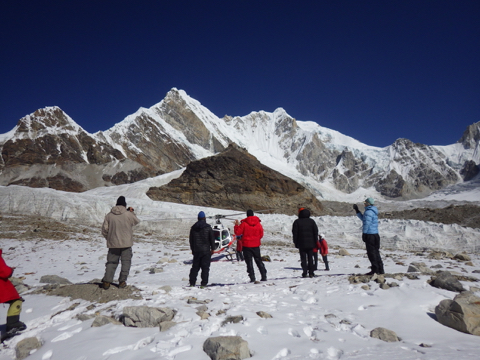
Waving goodbye to Kathy
Now, the climbing team was 4-Paul, Denise, Nick and me.
Advance Base Camp to Camp 1
On November 7, we set off for Burke-Khang, with a goal to reach Camp 1 on the mountain. The move from Advance Base Camp to Burke-Khang required us to descend back down into the Guanara Glacier and then move up the glacier to the foot of the East Buttress of Burke-Khang. This took about 5 hours, and the climbing was much like the move from Base Camp to Advance Base Camp. When we finally reached the foot of Burke-Khang, we were overcome by the up-close and personal sight of this towering, powerful and magnificent peak. Our emotions welled up inside us as we contemplated our first footsteps on this remote, unclimbed and mysterious Himalaya mountain.
As planned, our route up Burke-Khang began with an extremely difficult, challenging and vertical move up the East Buttress, a 2,000 foot wall of snow and ice that appeared to have no terminal point. As I gazed up at the Sherpa team moving up the East Buttress, they looked like tiny marching ants, and I commented to no one in particular “it doesn’t look like they are even moving.” But, they were moving, and so was the rest of the climbing team, so I started my move up behind them.
The move up the East Buttress route began with a scree field of loose rock and boulders, which often resulted in one step up, only to slide two steps back down the mountain. I longed for the beginning of the snow and ice where our crampons could gain purchase on the mountain. After enduring about 1 hour of this floundering and frustration in the scree field, I finally reached the snow and ice where the fixed lines began. I was so grateful to be able to strap on my crampons and deploy my jumar (climbing device that slides up the fixed line, but will not slide down, thus preventing the climber from falling). I was stunned at the vertical pitch of the East Buttress, which was consistently at, or above, 75 degrees.
The move to Camp 1 seemed interminable. And, to make maters worse, my mind began to play tricks on me. I imagined I could see a ridgeline in the far distance up the Buttress, and I prayed “please God make Camp 1 just over that ridge.” I desperately needed the shelter and rest of a tent on the mountain. But, there was no ridge on the Buttress, just more vertical Buttress! The ridge I imagined was only a mirage, a figment of my imagination. It was like paddling out into the ocean towards the horizon, reaching the horizon, and realizing nothing has changed, it is just more ocean. I felt like I was climbing a pyramid that had no apex. This went on for so many hours I lost count. Finally, I crested a ridge at the top of the East Buttress, and the tents were now in sight. Hallejuia and praise the Lord!

The East Buttress
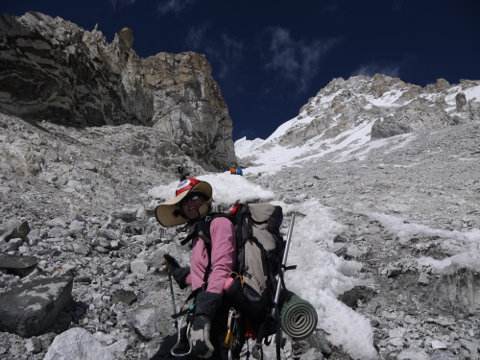
Denise moving up the East Buttress
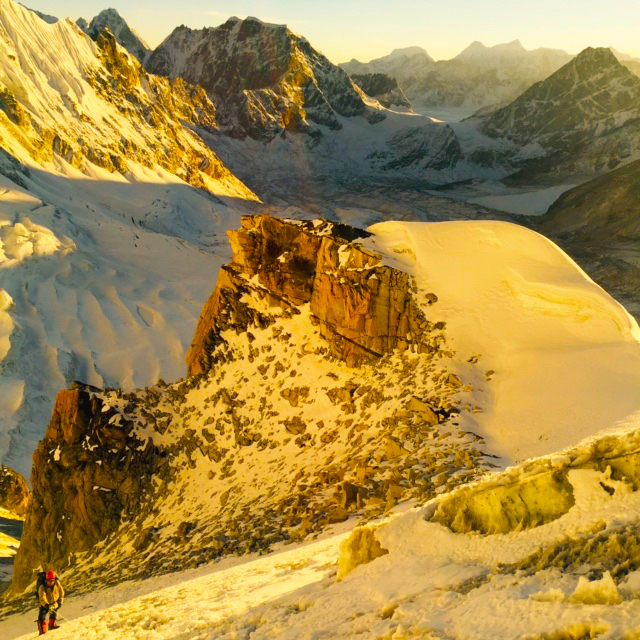
Bill moving up the East Buttress

Looking down the East Buttress
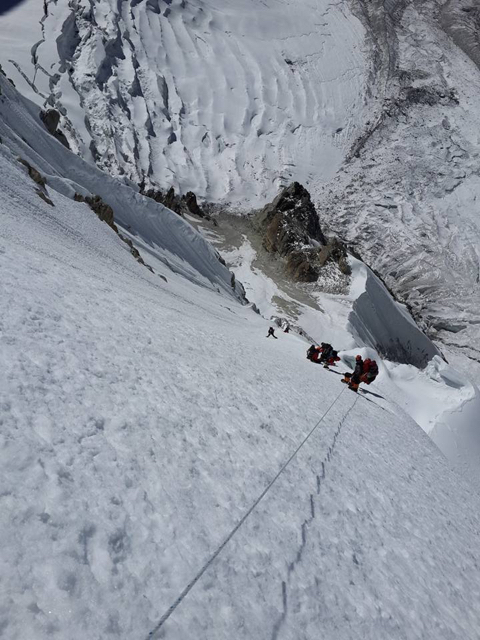
The East Buttress
Camp 1
Camp 1 consisted of 5 tents perched on a flat snowfield at the top of the East Buttress. Paul and Denise shared a tent. Garrett and Sid shared a tent. Nick and I shared a tent. And, the Sherpas shared the remaining tents. The altitude of Camp 1 was 20,283 feet. The weather was bluebird perfect, as it was for most of the trip.
Because of a significant crevasse and avalanche risk, Garrett and Sid made a change in the route from the original plan that Garrett and I worked out based on our April helicopter reconnaissance. Instead of following a wide loop across the snowfield and up the bottleneck on the left side of the snowfield, the route we would follow would move directly up the ridgeline on the right side of the snowfield. This change in route increased our margin of safety but immeasurably increased the difficulty and technical nature of the climb.
Garrett also suggested another change in plans. Instead of establishing a second camp on the mountain at the base of the summit ridge headwall, we would all move on the very next day from Camp 1 to the summit and then back to Camp 1. The reason for this change was his determination that the Sherpa team was too depleted to establish another full camp higher on the mountain. This was a concern to me because I had counted on that second camp to break up my summit day. I was not confident I could move from Camp 1 to the summit and back in one push. This was consistent with my strategy on the South and North sides of Mt. Everest where I spent a night at the high camps to maximize my energy and chances of success on summit day. Most teams do not follow that protocol on Mt. Everest because of the abject danger presented by the thin air at the high camps on the South and North sides of the mountain.
What we worked out with the approval of the team was that the team would take a rest day at Camp 1, and Sid and I would move up the following day (November 9) to establish a Camp 2 on the mountain, consisting of one tent, while the rest of the team would take another rest day at Camp 1. The following day (November 10), the Camp 1 summit team (Garrett, Paul, Denise and Nick) would begin an early morning summit push from Camp 1 and I would begin a later morning summit push from Camp 2. The plan was for the Camp 1 summit team to catch up with me so we could all reach the summit together.
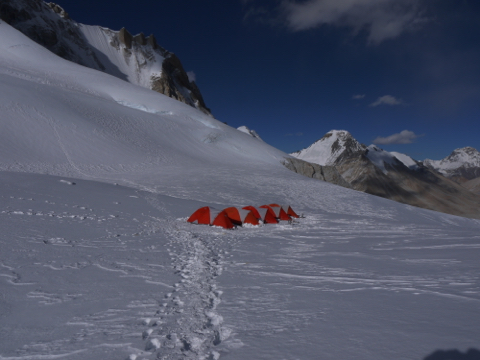
Camp 1

The view of the Burke-Khang summit from Camp 1

Mt. Everest from Camp 1
Camp 1 to Camp 2
Garrett and Sid’s decision to change the route from Camp 1 to the summit was a wise and judicious response to the objective dangers presented by our original plan. But, the new route foreshadowed a major change in the physical, technical and emotional difficulty of the climb. Instead, of a gradual move up the snowfield and the bottleneck to the base of the summit ridge headwall, we would be moving directly up the spine of the mountain on the right side of the snowfield. This involved more 75-plus degree vertical snow and ice climbing as well as highly technical rock climbing as the spine was laced with many massive ice-covered rock walls.
Sid and I began our move to Camp 2 at dawn on November 9, and to describe our day would only repeat what I have already said about the move the previous day to Camp 1. It was a long, tough day, and, after 8 hours of climbing, we finally reached Camp 2. The altitude at Camp 2 was 21,857 feet. The summit ridge was just about 700 feet above us, so things were now looking really good. We entered the tent and enjoyed a good night’s sleep.
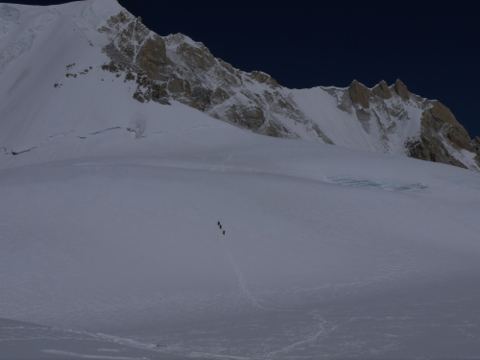
Moving up to Camp 2
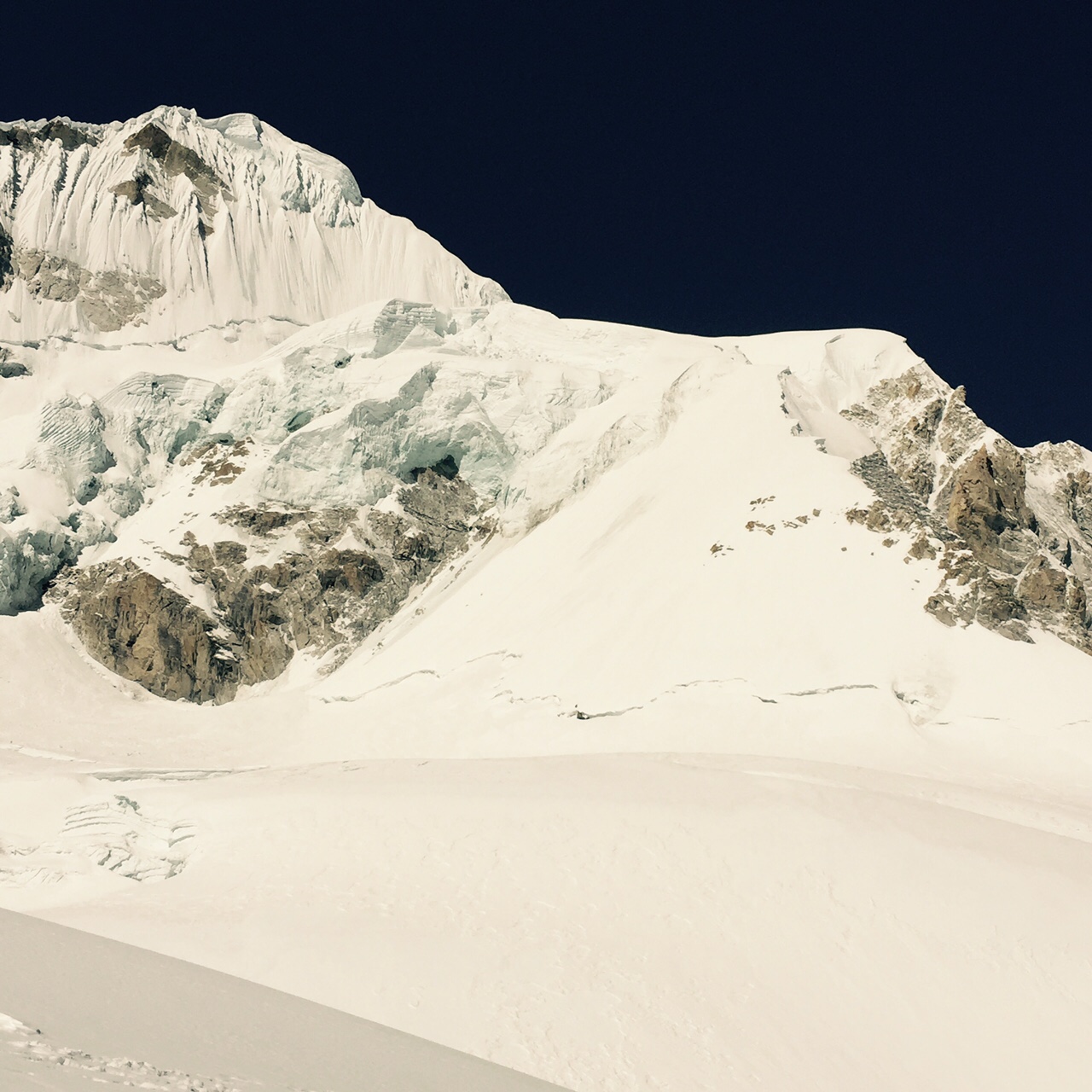
The route from Camp 1 to Camp 2 up the spine of the mountain through the rocks on the right side of the snowfield
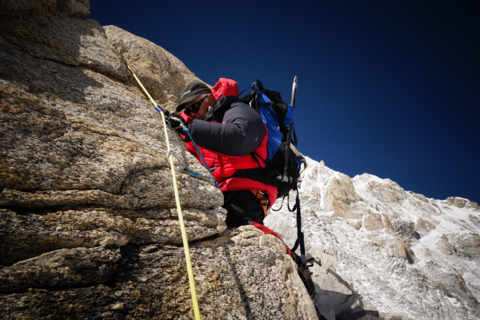
Technical rock climbing by Bill

Sid moving up to Camp 2
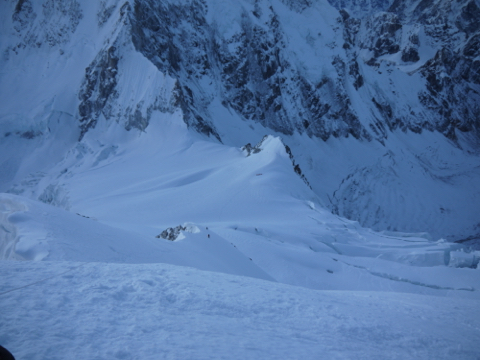
Looking down towards Camp 1. Note the 2 climbers, appearing as dots in the middle of the photo, moving up to Camp 2
Summit Day
Our plan for summit day was to leave Camp 2 at dawn on November 10 and summit in the early afternoon. Our expectation was that the Camp 1 summit team, which had departed from Camp 1 at 3 am in the morning, would catch up with us and the entire team would summit together.
The route from Camp 2 to the summit moves approximately 700 feet up the summit ridge headwall (which we named “The Fejtek Face”) to the summit ridge, where it turns sharp left to the summit at 22,750 feet. The fixed lines had been set from Camp 2 up the Fejtek Face to the summit ridge. However, significantly, the Sherpa team had not yet fixed the lines along the summit ridge to the summit. So, the Sherpa team set out ahead of us to complete this final task.
Sid and I left at dawn and steadily made our way up the Fejtek Face. I was tired, but felt physically fit and mentally optimistic that we would easily reach the summit. But, when Sid and I were just about 300 feet from the summit ridge, we heard radio reports that the Sherpa team was encountering difficulties fixing the lines along the summit ridge to the summit. The Sherpa team was fixing the lines on the Tibetan side of the mountain, so they were out of our line of site. Sid scrambled up the headwall to the summit ridge and disappeared over the ridge into Tibet. I decided to stay put and conserve my energy for the final move when I received the signal that the lines were fixed. I sat on the lip of a giant crevasse that seemed to descend into a black hole of oblivion. It was peaceful, quiet and serene where I sat and waited, but, unknown to me, all hell was breaking loose on the Tibetan side of Burke-Khang.
Meanwhile, I could see tiny figures milling around Camp 2 far below me. It was Garrett, Nick and Paul, who had arrived at Camp 2 from Camp 1. Denise had opted to stay at Camp 1 as she judged the danger of the move to the summit beyond her level of risk tolerance. Finally, I saw one figure clip into the line and start moving up toward me. It was Paul. When he reached earshot, I heard him yell “I want to talk to you.” I knew immediately what that meant, and I mustered all the arguments I could think of as to why it was premature to give up our move to the summit at this juncture, especially given how close we were to the summit. There was no way I was going down as long as there was hope the line fixing would be successful. We were less than 400 feet from the summit and I judged most of that footage would be an easy traverse across the summit ridge to the summit. Paul and I had our conversation, and, in the end, I said let’s wait and see how things develop on the other side of the mountain. I also had a radio conversation with Garrett, who was monitoring the line fixing activities from Camp 2. He concurred we should wait and see if the Sherpas could complete the line fixing to the summit.

The view from Camp 2 up the Fejtek Face to the summit ridge headwall. Note the climber half-way up the headwall
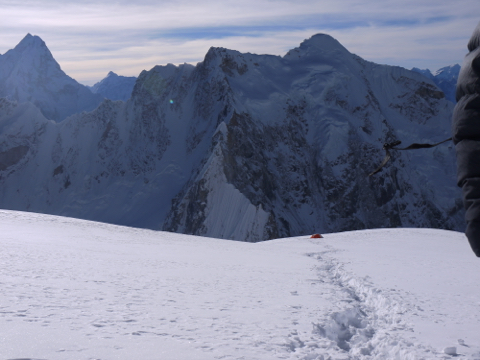
Looking down the Fejtek Face at Camp 2
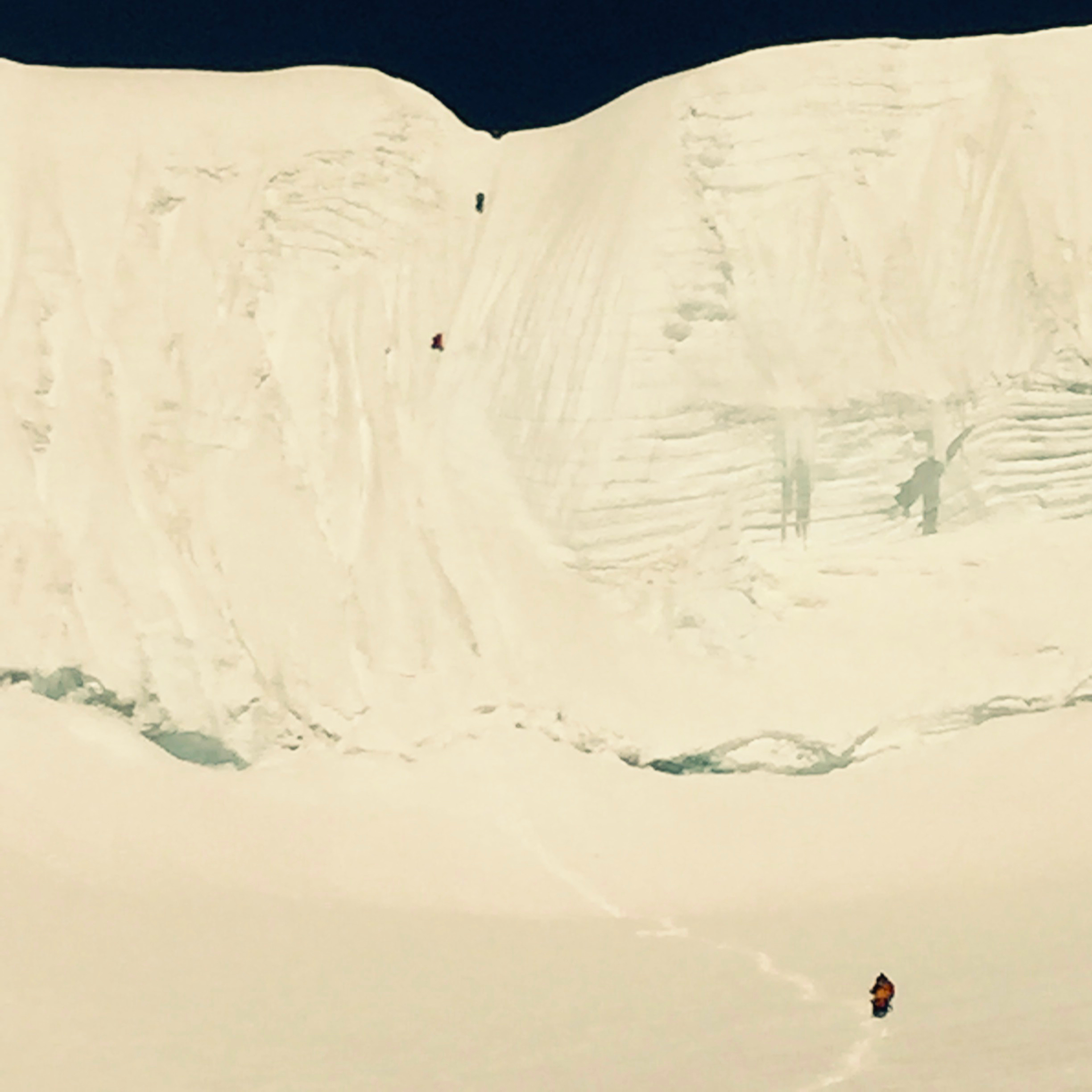
The massive, vertical summit ridge headwall. Bill approaching the headwall
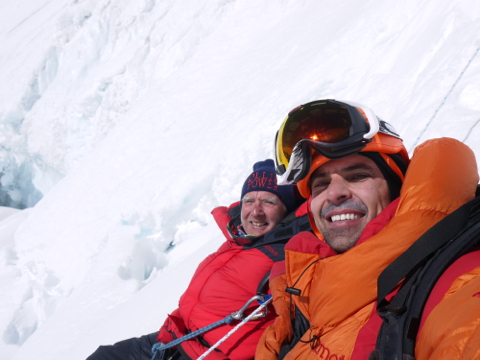
Paul & Bill resting on the summit ridge headwall
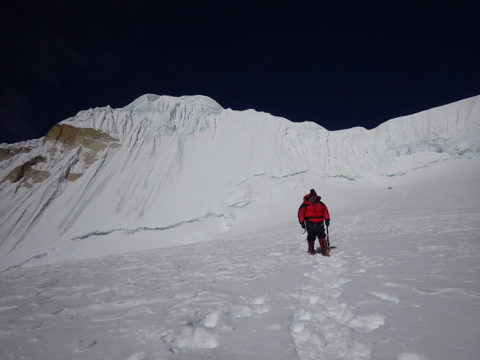
Bill reurning to Camp 2
High Drama on the Summit Ridge
Little did we know of the challenges facing Sid and the Sherpa team on the other side of the mountain in Tibet. Burke-Khang had established a virtually impenetrable fortress guarding the summit, and the fortress extended all the way up the summit ridge. Our highly experienced Sherpas said they had never seen anything like these defensive emplacements on a Himalaya peak.
First, they encountered two cornices on the summit ridge-one facing south and one facing north. A cornice is formed by the force of the wind blowing snow and ice over the top of the mountain. This creates a build-up of snow and ice that generally overhangs the mountain. Cornices can be many feet deep or just inches deep. But, they are always very unstable and susceptible to collapse, especially as the snow and ice forming the cornice melt in the sun. Since the wind generally blows in only one direction over a mountain, the cornice usually forms in the direction of the wind flow. It is unheard of to encounter two cornices facing in opposite directions on the same mountaintop. But, this is exactly what the Sherpas encountered on Burke-Khang.
Second, the dual cornices on Burke-Khang were bisected by a giant black-hole crevasse. So, a fall off either cornice would land the climber either 10,000 feet down the mountain into Nepal or Tibet or into the jaws of the bottomless crevasse.
Third, just beyond the double cornices, and within just feet from the summit, was yet another cornice that formed a concave, nearly 100% vertical, ice wall that could only be scaled by an experienced ice-climbing team with technical ice climbing equipment.
Fourth, overlaying all of these risks, the snow on the summit ridge varied from deep snow, which was difficult to plow through, to light, sugary snow sitting on top of treacherously dangerous and unstable blue ice.
These were the physical challenges on the summit ridge. The mental challenges were even more daunting. Sid told us both he and every member of the veteran Sherpa line fixing team were terrified while trying to negotiate these challenges and fix the lines on Burke-Khang. For each Sherpa, it was not a singular risk just to that Sherpa. If one Sherpa fell, or if either cornice collapsed, every Sherpa clipped into the line would fall to his death.
One Sherpa made an effort to climb up on the first cornice and fix the lines. When he planted his ice axe in the cornice to gain balance and footing, his ice axe went clear through the cornice. When he pulled his ice axe out of the cornice, it left a hole in the cornice and, as he peered through the hole, he could see 10,000 feet down to the Tibetan plateau. Another Sherpa made the same effort and started a death slide off the cornice, which he was fortunately able to arrest.
It was time for hard decisions to be made concerning our expedition. Garrett answered the call.
As Paul and I sat patiently on the Nepal side of the mountain, we were oblivious to the life and death struggle occurring just over the summit ridge in Tibet. Then, suddenly, the radio crackled to life. It was Garrett summoning all Sherpa and climbing team members back to Camp 2. Our summit day was over. I spoke with Garrett and he explained the decision.
My emotions ranged from disappointment to relief. Of course, I was disappointed our team did not reach the summit of Burke-Khang. But, that disappointment was far exceeded by sheer joy that no one was going to perish trying to climb my mountain. After hearing reports from Sid and the Sherpa team, I am 100% convinced our expedition would have suffered deaths on Burke-Khang had we not terminated the summit push. The lives of Nepalese and American families would be forever changed. Every single member of the Sherpa team and the climbing team would be grieving the losses, and our collective guilt would be palpable. Instead, the decision that was made permitted all of us to celebrate our outstanding success on Burke-Khang and savor our good memories from the expedition, untainted by guilt, shame and second-guessing poor choices made on the mountain.
I have climbed Mt Everest 6 times and summitted twice. The best decisions I ever made on that mountain were the decisions I made the 4 times I turned around and went down within less than 1,000 feet from the summit. The same good decisions were made on Burke-Khang, and I will always be proud of that fact.

The treacherous, heavily corniced and crevassed summit ridge

The double cornice on the summit ridge

Note the crevasse bisecting the right side of the cornice

The summit ridge

Our brave line fixing team at their high point on Burke-Khang, just feet from the summit-Sid Pattison, Phurba Sherpa, Ang Di Sherpa and Karma Sherpa
Camp 1 to Advance Base Camp
We all moved down to Camp 1 where we spent the night. On November 11, we moved to Advance Base Camp where we spent another night. The original plan was for the team to return to Base Camp and then trek back to Lukla via the Everest Trekking Trail. But, after our exhausting ordeal on the approach to Burke-Khang, and while on the mountain, no one had an appetite to stick with this schedule. On November 12, we all flew from Advance Base Camp to Lukla in helicopters.
Bill Burke
Post Script:
How would you evaluate the Burke-Khang expedition?
This was my dream expedition come true. Everything about the trip was special and magical. Our team of climbers, trekkers and guides was tight-knit and close, and the resulting high morale boosted our level of satisfaction and success. We were truly a Band of Brothers. No one on the team had trekked or climbed above Base Camp, so everything we saw and experienced from that point on was a first-time experience for everyone. The Gokyo Valley was spectacular and beautiful, just as we had been told. Burke-Khang has never been climbed, so our footsteps were fresh and new on the mountain. The mystery, power and grandeur of the mountain will forever be etched in our memories. By all reasonable standards of success, we succeeded in our quest as we climbed as high up the mountain as humanly possible. God blessed our expedition in every way possible.
How would you rank Burke-Khang in difficulty vs Mt. Everest?
I think the Burke-Khang climb was harder than climbing Mt. Everest, even harder than climbing the North side of Mt. Everest. Burke-Khang’s altitude is 6,000 feet lower than Mt. Everest, but the climbing is consistently vertical. I was shocked and stunned at the consistently extreme vertical pitch of the mountain. Even now, I can’t reconcile this with the photos and video footage from our April helicopter reconnaissance of the mountain. I knew the East Buttress would be challenging and extremely vertical. But, the photos and video footage above the East Buttress ridgeline seem to show a more gradual vertical rise to the summit ridge headwall. Not so. The entire climbing route was 75 degree vertical, and more. The whole time I was on the mountain, I felt like I was scaling a pyramid. I’m not sure I will ever trust a mountain photo again.
In addition, the approach to Burke-Khang up and across the Ngozumba and Guanara Glaciers was grueling and energy sapping, much more so than the approach to Mt. Everest from the South and North sides.
How would you rate the Burke-Khang expedition among your alpine experiences?
This is like asking me to rank my children. I love them equally and for different reasons. It is really hard to top a summit experience on Mt. Everest, especially a summit experience from both the South and North sides. Burke-Khang was unique because it bears my name and has never been climbed. Also, I love the toughness of the mountain-it put up a ferocious battle and threw everything at us from the moment we set foot on its previously untouched flanks. Burke-Khang’s unprecedented defensive emplacements on its summit ridge were truly impressive and eventually won the day. You have to admire a mountain with those qualities. I suppose one way of looking at the experience is that there were only 2 options–I would succeed in scaling the mountain, or the mountain would succeed in repelling me. Either way, it’s all in the family.
Will you try again?
I would like to be the first person to climb my mountain. Within days of coming down the mountain, I was pondering new climbing routes and strategies. I have some ideas.
As the Terminator once famously said “I’ll be back.”
